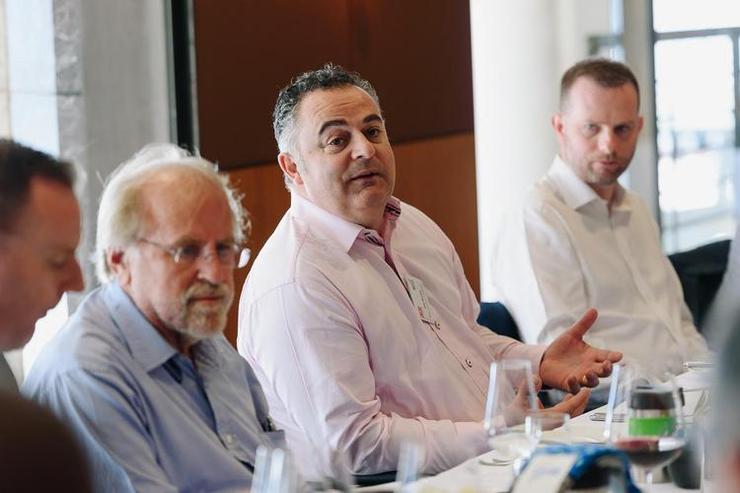
Juniper’s Jim Burke: AI provides insight not previously possible, especially as the volume and complexity of devices continues to increase
Artificial intelligence (AI) – it’s a nebulous term that means many things to different people. What is true is that one day in the near future, machines will be likely to possess ‘human-level’ intelligence, providing organisations with efficiencies that they have never seen before.
But what role is AI playing inside organisations today, particularly when it comes to providing a good experience for internal users and external customers across their wide area networks?
Tech execs gathered in Sydney in September to discuss the benefits of using artificial intelligence technologies inside their wired and wireless networks.
Jim Burke, general manager at Juniper Networks, said that an AI-driven network not only maximises the user experience through better performance and reliability while lowering IT costs through better efficiencies.
“For example, if something goes wrong, our AI-driven virtual assistant can easily pinpoint the source of the problem. [It will ask] was it a network, device or application issue? There is no need to hunt through event logs or dashboards or send anyone onsite with handheld devices to try and recreate problems,” said Burke.
This capability is provided by AI-driven wireless networking equipment provider, Mist, which Juniper acquired in March this year for US$405 million.
Burke said Mist’s equipment actively notifies IT departments of problems before users often know they exist and enables full automation of help desk tasks.
“This eliminates the time and money previously spent troubleshooting networks. In fact, one Mist partner estimated up to 40 per cent savings in operational expenditure due to AI,” he said.
Burke adds that AI provides insight not previously possible, especially as the volume and complexity of devices continues to increase. He said that most IT departments recognise this is an enormous benefit, not a threat.
“In fact, it is the option for keeping up with the complex requirements of the smart device era. AI also provides much needed automation that reduces errors from manual configuration. One customer has moved from deploying three new sites per week to 300 new sites per night using the Mist technology,” he said.
Burke adds that Mist has a saying: “Up is not the same as good.”
This means that just because a network is operational doesn’t mean users are having a good experience.
“By delivering a more user-centric model using AI, the technology lets IT focus on delivering the best user experiences,” he said.
Joe Perricone, chief operating officer, at Swanson Health Asia Pacific, said his organisation is using AI-driven network applications to assist in monitoring of front and back end infrastructure services. This allows a direct connection and proactive approach with its customers and users of its systems, he said.
“Furthermore, the reliance of our AI is critical to the performance of our manufacturing and job dispatching processes, as well as the efficient delivery of goods and services in the field,” he said.
“This is achieved by creating intelligence connections with our key applications.”
Perricone added that using the power of AI, the organisation is able to capitalise on faster delivery times and routes.
Swanson Health’s mobile workforce can proactively report on issues, and tasks are automated immediately to the right person or prioritised where everyone has access to all the information required to complete tasks un a unifed and collaborative manner, resulting in better use of resources and cost savings, he said.
“Our marketing efforts involve sending more specialised communications at a higher frequency, targeting specific customer segments with specific product ranges,” he said.
“This makes it difficult to do A/B tests manually. It might take a few weeks to run a single test so doing this for hundreds of product ranges is a considerable task. Our marketing application needs to be able to monitor the performance of the communications being sent and make adjustments accordingly to improve the communication and performance of our teams.”
Meanwhile, Adam Rendulic, director of IT, ANZA at materials manufacturer, Kion Group, said his organisation is not yet using artificial intelligence across its networks but it has ‘some AI’ or predictive/adaptive learning capabilities within its storage array.
“This is beneficial in highlighting concerns or areas that are not optimally configured and ensuring bottlenecks are addressed. Also, if a pattern is detected within the customer base, it will then look for other customers with similar parameters and inform them of the issue before it manifests,” he said.
Russell Morris, chief information officer at TransGrid, said the electricity network operator has started developing AI-driven networks and has subsequently deployed an SD-WAN solution which is being resold to a telecommunications business.
“SD-WANs are more resilient to faults and have some self-healing capabilities, leading to improved customer uptime,” he said.
Morris added that a combination of factors are used to deliver a better user experience.
“Linking our service desk and self-service [capabilities] with ServiceNow allows the equipment to log faults proactively so we can spot trends early and maintain service levels,” he said.
Automation and the question of job losses
As with any automation activity, adding AI capabilities to the network can strike fear amongst staff that introducing the technology will result in job losses.
IT skillsets always need to evolve and AI is simply another tool that needs to be leveraged as an organisation grows and evolves into the modern era, said Burke.
“With AI, IT saves time and money, optimises user’s experiences and maximises available resources. Staff can shift from many, rote tasks to projects that deliver more value for the business.”
Andrew Atkin, head of information technology Asia Pacific at chocolate maker Lindt & Sprungli, agrees.
“For AI, machine learning and automation technologies, there is no consideration of job losses. With the removal of manual and repetitive tasks, people can concentrate on the value-added and analytical tasks to bring real value to the business.”
Finally, Swanson Health’s Perricone said the organisation has not had to decrease or increase staffing levels due to the effectiveness of AI technologies.
“We have found the use of AI technologies not only enables better cost management, it also provides more room for quality control, resulting in better outcomes for our customers.
“We need to develop and evolve further data and AI-driven workflows that can help us understand our customers better, predict trends in the market and adapt accordingly.”
Tags juniper networksAItransgridJoe Perriconeartificial intelligenceMistKion Groupwide area networksAdam RendulicAndrew AtkinSwanson HealthRussell MorrisJim Burke
read more at https://www.cio.com.au/tax/news/ by CIO Staff
Cio







